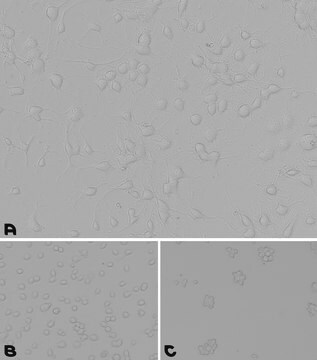A-005-M
Poly-ʟ-Lysine Hydrobromide
synthetic, liquid, 0.1 mg/mL, suitable for cell culture
Synonim(y):
Lysine
About This Item
Polecane produkty
product name
Poly-L-Lysine Solution, 0.01%
rozmiar igły
2.0 mm
Poziom jakości
sterylność
sterile
Postać
liquid
masa cząsteczkowa
Mw 84000 Da
producent / nazwa handlowa
NovaSeptum®
stężenie
0.01 % (w/v)
0.1 mg/mL
metody
cell attachment: suitable
cell culture | mammalian: suitable
Warunki transportu
dry ice
temp. przechowywania
−20°C
Opis ogólny
The molecular weight of Poly-L-Lysine for cell culture can vary significantly, with lower molecular weight (30,000 Da) being less viscous and higher molecular weight (greater than 300,000 Da) having more binding sites per molecule. This product uses a Poly-L-Lysine of 84000 Da, yielding a solution viscosity for easy handling while providing sufficient binding sites for cell attachment.
Zastosowanie
Działania biochem./fizjol.
Jakość
Uwaga dotycząca przygotowania
1. Thaw Poly-L-Lysine solution at room temperature.
2. Dilute Poly-L-Lysine solution to the desired concentration in sterile water.
3. Fully coat the cell culture surface with diluted Poly-L-Lysine solution. Use 5 mL volume for 6-cm plates and 10 mL volume for 10-cm plates and T75 flasks.
4. Allow the cell culture vessel to sit at room temperature overnight.
5. Aspirate the Poly-L-Lysine solution the following day and rinse the vessel with sterile water followed by coating with desired ECM protein.
Informacje prawne
Kod klasy składowania
12 - Non Combustible Liquids
Klasa zagrożenia wodnego (WGK)
WGK 1
Temperatura zapłonu (°F)
Not applicable
Temperatura zapłonu (°C)
Not applicable
Certyfikaty analizy (CoA)
Poszukaj Certyfikaty analizy (CoA), wpisując numer partii/serii produktów. Numery serii i partii można znaleźć na etykiecie produktu po słowach „seria” lub „partia”.
Masz już ten produkt?
Dokumenty związane z niedawno zakupionymi produktami zostały zamieszczone w Bibliotece dokumentów.
Klienci oglądali również te produkty
Produkty
Białka macierzy zewnątrzkomórkowej, takie jak laminina, kolagen i fibronektyna, mogą być stosowane jako podłoża do mocowania komórek w hodowli komórkowej.
Extracellular matrix proteins such as laminin, collagen, and fibronectin can be used as cell attachment substrates in cell culture.
Nasz zespół naukowców ma doświadczenie we wszystkich obszarach badań, w tym w naukach przyrodniczych, materiałoznawstwie, syntezie chemicznej, chromatografii, analityce i wielu innych dziedzinach.
Skontaktuj się z zespołem ds. pomocy technicznej










